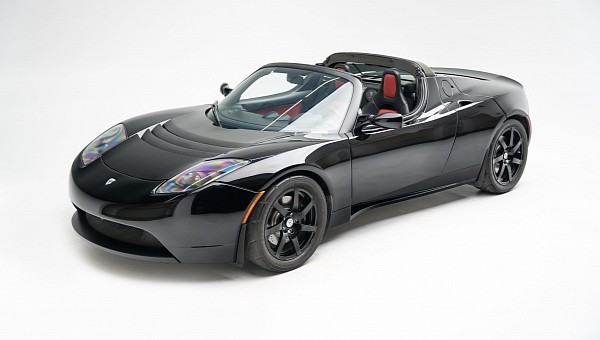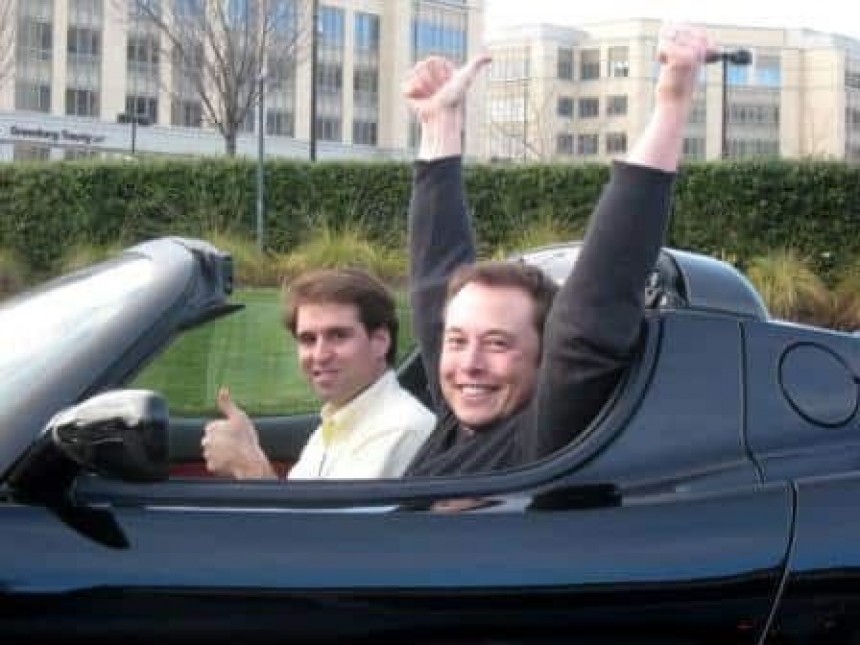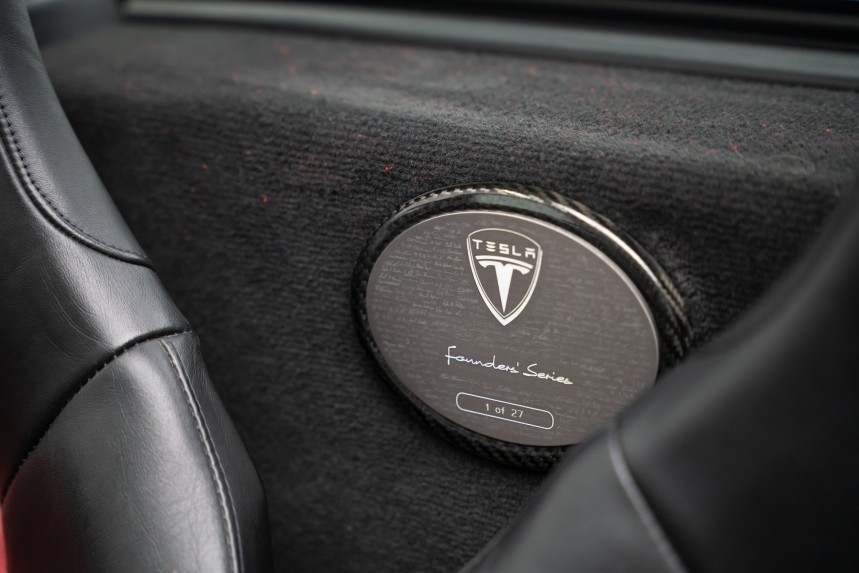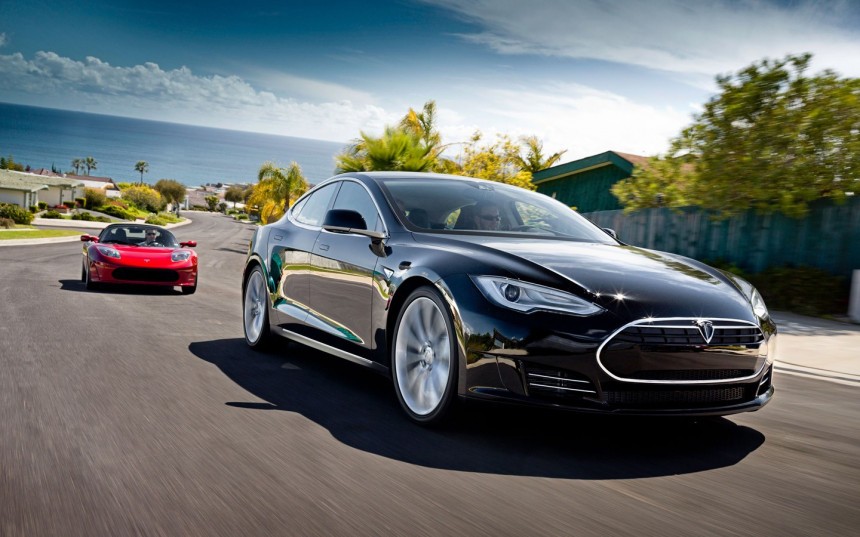Elon Musk received the keys to the first production-spec Tesla Roadster a little over 15 years ago. Prior to the handover, San Carlos-based employees received an email that informed them of the moment everyone was waiting for since the first prototype was unveiled in July 2006.
It was a watershed moment for Tesla, with select media in attendance to witness the silent revolution that made EVs exciting. Internally referred to as P1, the first example of the breed nearly didn’t make it in time. Stuck in customs, the vehicle would be released in the nick of time thanks to a few phone calls. The EV manufacturer’s problems weren’t over yet, though.
According to product planning director Zak Edson, who is currently serving as the vice president of sales and service at Lucid Motors, the car shipped by truck without a battery. That was pretty bad news for Tesla, who needed to demonstrate the Roadster to the media. If Elon Musk couldn’t drive Roadster P1 right there and then, that would have attracted the kind of criticism that Tesla just could not afford back in February 2008.
The service team rolled the car into Tesla’s facility, installed the Energy Storage System for a good two hours, while Elon Musk was giving interviews, then checked everything over before turning the key. In case you weren’t feeling old enough, the answer is yes. Roadster P1 features a good ol’ key that needs to be turned in the ignition for the car to start up.
What’s most impressive about that fateful day isn’t the fact that the ESS was married to the vehicle in record time. The service time had experience doing it, but never had they installed an Energy Storage System in a production-ready vehicle. On the clock. And in front of so many people.
The South Africa-born magnate jumped into P1, turned the key, and took a victory lap down Palo Alto’s University Avenue with four prototypes in tow. Although it wasn’t exactly sunny that Friday afternoon, every single Roadster paraded down highway 101 in Silicon Valley with the tops off.
Mere weeks later, Elon Musk praised his black-painted roadster in a blog post on Tesla’s website. He had been driving it every day from Bel Air to Hawthorne and back that month. The self-described Technoking famously said that it was the most fun car he had ever owned, beating out the McLaren F1 and Porsche 911 Turbo he rocked at that time. Genuine excitement or exaggerated drivel meant to impress the media, you be the judge of that.
Love him or hate him, Tesla big kahuna Elon Musk had reasons to celebrate together with Martin Eberhard and Marc Tarpenning. We also have to remember that Ian Wright – Tesla’s third employee – and chief technical officer J. B. Straubel are also considered co-founders of Tesla.
Come April 2010, more than 900 examples of the Roadster had been reserved. When Lotus ended production of the Elise-Exige-Evora triplets in December 2021, it mentioned that 2,515 units of the Roadster were produced between 2007 and 2012. This grand total is disputed, but on the other hand, everyone agrees that 2,500-ish is a good enough estimate.
Even though it features a Lotus-designed platform, the first-gen Roadster differs from the Elise and Exiga of that era in many respects. The longer wheelbase and stiffer chassis are complemented by rather expensive body panels constructed from resin transfer molded carbon fiber composite. By comparison, Lotus used a system for injecting polyester resin and glass fiber into a mold. The panels were then assembled at Hethel, in the UK.
Similar in proportions to the open-top Elise, the Roadster spawned no fewer than four versions. The first iteration had its bodywork made by Sotira 35 in France, including the front and rear bumpers. Developed by AC Propulsion, the electric architecture included a three-phase and four-pole induction electric motor with a maximum output of 248 horsepower.
Originally capable of 244 miles (nearly 393 kilometers) on a single charge, the first iteration can reach 60 miles per hour (97 kilometers per hour) in 4.6 seconds. $98,950 was the base specification’s price, which is a lot even without accounting for inflation. The 2.5 Sport cranked things up to $128,500, and the R80 upgrade – a.k.a. 3.0 – retailed at $29,000 when it was introduced in 2014, two years after the final Roadster was produced.
As implied by the headline, the Roadster would help Tesla learn a few valuable lessons. Model S development kicked off under the codename WhiteStar prior to Roadster P1’s outing. A prototype was unveiled in 2009, then the real thing made its debut in 2012 as a five-door liftback sedan.
Bodied in aluminum rather than carbon fiber, the Model S launched with a few parts from the Mercedes-Benz parts bin. Now based in Texas, the electric vehicle manufacturer knew that it had to be frugal wherever possible in order to make the Model S financially viable. Had Tesla kicked off its EV-making journey with a carbon fiber-clad Model S full of pricey bits and bobs, chances are that Tesla might have gone under incredibly fast.
It, fortunately, did not, and better still, it acquired the financial resources and know-how necessary to expand its one-model lineup to a grand total of four nameplates. The S-3-X-Y quartet will be soon joined by the still-under-development Cybertruck, which has been pushed back to 2024. Oh, and by the way, don’t forget that Tesla also produces a full-electric semi.
In keeping with the original Roadster, every single passenger vehicle currently manufactured by Tesla offers a good reason to switch from internal combustion to all-electric propulsion. The Model S, 3, X, and Y can all be specified with performance-oriented powertrains. The three-motor setup of the Model S Plaid and Model X Plaid stands out as the wildest of the bunch, packing a simply ridiculous 1,020 peak horsepower.
On an ending note, Tesla hasn’t forgotten how it all started. Elon Musk was there to witness the difficult birth of the first-generation Roadster. He’s also championed the second-generation Roadster, which was first teased in 2014, as the Model R. A prototype was revealed in November 2017, during the Tesla Semi event, but the production-spec Gen 2 is nowhere to be seen. Chief designer Franz Von Holzhausen recently said that the all-new Roadster isn’t a priority as of early 2023. So, it's coming next year, then?
According to product planning director Zak Edson, who is currently serving as the vice president of sales and service at Lucid Motors, the car shipped by truck without a battery. That was pretty bad news for Tesla, who needed to demonstrate the Roadster to the media. If Elon Musk couldn’t drive Roadster P1 right there and then, that would have attracted the kind of criticism that Tesla just could not afford back in February 2008.
The service team rolled the car into Tesla’s facility, installed the Energy Storage System for a good two hours, while Elon Musk was giving interviews, then checked everything over before turning the key. In case you weren’t feeling old enough, the answer is yes. Roadster P1 features a good ol’ key that needs to be turned in the ignition for the car to start up.
What’s most impressive about that fateful day isn’t the fact that the ESS was married to the vehicle in record time. The service time had experience doing it, but never had they installed an Energy Storage System in a production-ready vehicle. On the clock. And in front of so many people.
Mere weeks later, Elon Musk praised his black-painted roadster in a blog post on Tesla’s website. He had been driving it every day from Bel Air to Hawthorne and back that month. The self-described Technoking famously said that it was the most fun car he had ever owned, beating out the McLaren F1 and Porsche 911 Turbo he rocked at that time. Genuine excitement or exaggerated drivel meant to impress the media, you be the judge of that.
Love him or hate him, Tesla big kahuna Elon Musk had reasons to celebrate together with Martin Eberhard and Marc Tarpenning. We also have to remember that Ian Wright – Tesla’s third employee – and chief technical officer J. B. Straubel are also considered co-founders of Tesla.
Come April 2010, more than 900 examples of the Roadster had been reserved. When Lotus ended production of the Elise-Exige-Evora triplets in December 2021, it mentioned that 2,515 units of the Roadster were produced between 2007 and 2012. This grand total is disputed, but on the other hand, everyone agrees that 2,500-ish is a good enough estimate.
Similar in proportions to the open-top Elise, the Roadster spawned no fewer than four versions. The first iteration had its bodywork made by Sotira 35 in France, including the front and rear bumpers. Developed by AC Propulsion, the electric architecture included a three-phase and four-pole induction electric motor with a maximum output of 248 horsepower.
Originally capable of 244 miles (nearly 393 kilometers) on a single charge, the first iteration can reach 60 miles per hour (97 kilometers per hour) in 4.6 seconds. $98,950 was the base specification’s price, which is a lot even without accounting for inflation. The 2.5 Sport cranked things up to $128,500, and the R80 upgrade – a.k.a. 3.0 – retailed at $29,000 when it was introduced in 2014, two years after the final Roadster was produced.
As implied by the headline, the Roadster would help Tesla learn a few valuable lessons. Model S development kicked off under the codename WhiteStar prior to Roadster P1’s outing. A prototype was unveiled in 2009, then the real thing made its debut in 2012 as a five-door liftback sedan.
It, fortunately, did not, and better still, it acquired the financial resources and know-how necessary to expand its one-model lineup to a grand total of four nameplates. The S-3-X-Y quartet will be soon joined by the still-under-development Cybertruck, which has been pushed back to 2024. Oh, and by the way, don’t forget that Tesla also produces a full-electric semi.
In keeping with the original Roadster, every single passenger vehicle currently manufactured by Tesla offers a good reason to switch from internal combustion to all-electric propulsion. The Model S, 3, X, and Y can all be specified with performance-oriented powertrains. The three-motor setup of the Model S Plaid and Model X Plaid stands out as the wildest of the bunch, packing a simply ridiculous 1,020 peak horsepower.
On an ending note, Tesla hasn’t forgotten how it all started. Elon Musk was there to witness the difficult birth of the first-generation Roadster. He’s also championed the second-generation Roadster, which was first teased in 2014, as the Model R. A prototype was revealed in November 2017, during the Tesla Semi event, but the production-spec Gen 2 is nowhere to be seen. Chief designer Franz Von Holzhausen recently said that the all-new Roadster isn’t a priority as of early 2023. So, it's coming next year, then?




















